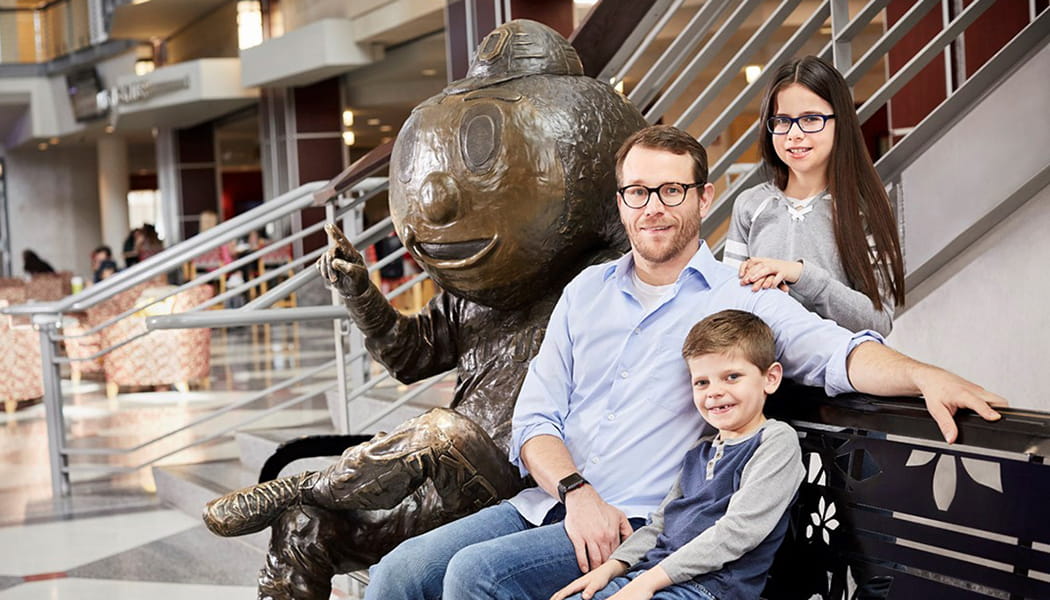The experts in the Department of Otolaryngology – Head and Neck Surgery at The Ohio State University Wexner Medical Center are ranked first in Ohio and third in the nation by U.S. News & World Report. What's happening here is remarkable and beautiful. It's important and it matters. Joshua Fellows knows firsthand what it means.
Fellows always had plenty of reasons to smile. A 2008 procedure at a different hospital left one side of his face paralyzed. A smile became impossible.
In late 2016, ENT surgeon Dr. Leslie Kim, director of Ohio State's Facial Plastics division, accepted Joshua as a patient.
"Restoring his smile was complicated," Dr. Kim says. "Smile muscles can atrophy irreversibly when they've been paralyzed for years."
But at Ohio State, the only central Ohio institution performing facial reanimation surgery, Dr. Kim's team was able to transplant a muscle from Fellows' leg to replace his smile function. By February 2017, Fellows could smile for the first time in nearly nine years. It restored his confidence, and his young children got to see their dad grin for the first time in their lives.
Adverse facial effects also have been dramatically reduced for patients at The Ohio State University Comprehensive Cancer Center – Arthur G. James Cancer Hospital and Richard J. Solove Research Institute (OSUCCC — James), where surgeons have revolutionized the removal of skull base tumors.
"Skull base tumors can often require incisions to the face, the side of the nose and the roof of the mouth," says Dr. Daniel Prevedello, director of Ohio State's Minimally Invasive Cranial Surgery Program and one of many neurosurgeons who collaborate with ENT teams for state-of-the-art care.
The OSUCCC – James procedure blends minimally invasive robotic surgery with endoscopic endonasal surgery, combining the expertise of brain surgeons and ear, nose and throat surgeons to remove such tumors through the nose or mouth.
Patients experience quicker recovery and are spared the pain and scarring that comes with open facial surgery.
"To our knowledge, we were the first to combine these two techniques in patients," says Dr. Ricardo Carrau, an otolaryngologist/head and neck surgeon at the OSUCCC — James.
Behind the scenes of life-changing procedures, ENT specialists are driving research in other areas. One growing area is cochlear implants, which are becoming more common as our population ages and is treated more often for acquired hearing loss.
Ohio State otolaryngologist Dr. Aaron Moberly is investigating why people with cochlear implants have varying success rates in understanding speech. Until Moberly's study, most research on cochlear implant success focused on device signal quality. But he's studying how patients' cognitive skills come into play.
"If we can predict who's likely to need extra help," Dr. Moberly says, "we can intervene with other therapies, potentially improving quality of life dramatically for those affected by severe hearing loss."
Meanwhile, researcher Irina Castellanos leads a team that's partnered with Nationwide Children's Hospital to examine quality-of-life outcomes for preschoolers who have the implants. The first-of-its-kind study will reveal how delays in language and executive functioning skills help explain and predict psychosocial development.
Understanding individual children's different neurocognitive factors can help health care teams provide better care for the whole person — not just for the ear — in childhood and beyond.
All of this is remarkable, and it is changing lives for the better. Ohio State is home to the most advanced, comprehensive ENT care in the region and some of the best specialists in the nation. And they're making a difference.
The world is changing. Medicine is changing. We’re leading the way.
Read more featured stories

